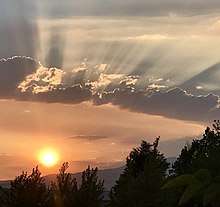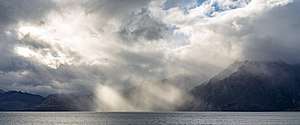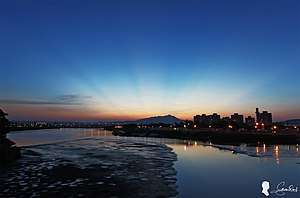Sunbeam
A sunbeam, in meteorological optics, is a beam of sunlight that appears to radiate from the Sun's position. Shining through openings in clouds or between other objects such as mountains and buildings, these beams of particle-scattered sunlight are separated by darker shadowed volumes. Despite converging toward (or radiating from) the light source, the beams are essentially parallel shafts of directly sunlit particles separated by shadowed ones. Their apparent convergence in the sky is a visual illusion from linear perspective. This illusion also causes the apparent convergence of the otherwise parallel lines of a long straight road or hallway at a distant vanishing point.[1] The scattering particles that make sunlight visible may be air molecules or particulates.[2]

Crepuscular rays
Crepuscular rays or "God rays" are sunbeams that originate when the sun is below the horizon, during twilight hours.[3] Crepuscular rays are noticeable when the contrast between light and dark is most obvious. Crepuscular comes from the Latin word "crepusculum", meaning twilight.[4] Crepuscular rays usually appear orange because the path through the atmosphere at sunrise and sunset passes through up to 40 times as much air as rays from a high midday sun. Particles in the air scatter short wavelength light (blue and green) through Rayleigh scattering much more strongly than longer wavelength yellow and red light.
Antisolar rays
In some cases, sunbeams may extend across the sky and appear to converge at the antisolar point, the point on the celestial sphere opposite of the Sun's direction. In this case, they are called antisolar rays (anytime not during astronomical night) or anticrepuscular rays (during the twilight period).[5] This apparent dual convergence (at both the solar and the antisolar points) is a perspective effect analogous to the apparent dual convergence of the parallel lines of a long straight road or hallway at directly opposite points (to an observer above the ground).[6]
Alternative names
- Backstays of the sun, a nautical term, from the fact that backstays that brace the mast of a sailing ship converge in a similar way
- Buddha rays[2]
- God rays, used by some members of the computer graphics industry[7]
- Jacob's Ladder[2]
- Light shafts, sometimes used in the computer graphics industry, such as the game engine Unreal Engine[8]
- Ropes of Maui, originally taura a Maui—from the Maori tale of Maui Potiki restraining the sun with ropes to make the days longer[2]
- Sun drawing water, from the ancient Greek belief that sunbeams drew water into the sky (an early description of evaporation)[2]
- Sunburst
- Tyndall rays
See also

References
- Schaefer, Vincent J.; Day, John A.; Pasachoff, Jay (1998). A Field Guide to the Atmosphere. Houghton Mifflin Harcourt. p. 169.
- Lynch, D. K.; Livingston, W. (1995). Color and Light in Nature. Cambridge: Cambridge University Press.
- Naylor, John (2002). Out of the Blue: A 24-Hour Skywatcher's Guide. Cambridge University Press. pp. 77–79.
- Edens, Harald. "Crepuscular rays". Weather Photography lightning, clouds, atmospheric optics & astronomy. Retrieved November 1, 2011.
- Cowley, Les. "Anti-solar (anti-crepuscular) rays". Atmospheric Optics. Retrieved March 19, 2015.
- Day, John A. (2005). The Book of Clouds. Sterling. pp. 124–27. ISBN 978-1-4027-2813-6. Retrieved 2010-10-09.
- E.g. this term is mentioned in: Krüger, Jens; Bürger, Kai; Westermann, Rüdiger (2006). "Interactive screen-space accurate photon tracing on GPUs" (PDF). Proceedings of the 17th Eurographics conference on Rendering Techniques (EGSR'06).
- "Light Shafts". Unreal Engine 4 Documentation. Archived from the original on 2018-11-17. Retrieved 2018-11-17.
External links
| Wikimedia Commons has media related to Crepuscular rays. |
